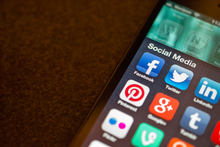
Social media are interactive technologies that facilitate the creation, sharing and aggregation of content (such as ideas, interests, and other forms of expression) amongst virtual communities and networks.[1][2] Common features include:[2]
- Online platforms that enable users to create and share content and participate in social networking.[2][3][4]
- User-generated content—such as text posts or comments, digital photos or videos, and data generated through online interactions.[2][3]
- Service-specific profiles that are designed and maintained by the social media organization.[2][5]
- Social media helps the development of online social networks by connecting a user's profile with those of other individuals or groups.[2][5]
The term social in regard to media suggests platforms enable communal activity. Social media can enhance and extend human networks.[6] Users access social media through web-based apps or custom apps on mobile devices. These interactive platforms allow individuals, communities, and organizations to share, co-create, discuss, participate in, and modify user-generated or self-curated content.[7][5][1] Social media is used to document memories, learn, and form friendships.[8] They may be used to promote people, companies, products, and ideas.[8] Social media can be used to consume, publish, or share news.
Popular social media platforms with over 100 million registered users include Twitter, Facebook, WeChat, ShareChat, Instagram, Pinterest, QZone, Weibo, VK, Tumblr, Baidu Tieba, Threads and LinkedIn. Depending on interpretation, other popular platforms that are sometimes referred to as social media services include YouTube, Letterboxd, QQ, Quora, Telegram, WhatsApp, Signal, LINE, Snapchat, Viber, Reddit, Discord, and TikTok. Wikis are examples of collaborative content creation.[according to whom?]
Social media outlets differ from old media (e.g. newspapers, TV, and radio broadcasting) in many ways, including quality,[9] reach, frequency, usability, relevancy, and permanence.[10] Social media outlets operate in a dialogic transmission system (many sources to many receivers) while traditional media operate under a monologic transmission model (one source to many receivers). For instance, a newspaper is delivered to many subscribers, and a radio station broadcasts the same programs to a city.[11]
Social media has been criticized for a range of negative impacts on children and teenagers, including exposure to inappropriate content, exploitation by adults, sleep problems, attention problems, feelings of exclusion, and various mental health maladies.[12][13] Social media has also received criticism as worsening political polarization and undermining democracy. Major news outlets often have strong controls in place to avoid and fix false claims, but social media's unique qualities bring viral content with little to no oversight. "Algorithms that track user engagement to prioritize what is shown tend to favor content that spurs negative emotions like anger and outrage. Overall, most online misinformation originates from a small minority of “superspreaders,” but social media amplifies their reach and influence."[14]
- ^ a b Kietzmann, Jan H.; Hermkens, Kristopher (2011). "Social media? Get serious! Understanding the functional building blocks of social media". Business Horizons (Submitted manuscript). 54 (3): 241–251. doi:10.1016/j.bushor.2011.01.005. S2CID 51682132.
- ^ a b c d e f Obar, Jonathan A.; Wildman, Steve (2015). "Social media definition and the governance challenge: An introduction to the special issue". Telecommunications Policy. 39 (9): 745–750. doi:10.2139/ssrn.2647377. ISSN 1556-5068. SSRN 2647377.
- ^ a b Cite error: The named reference
usersoftheworldwas invoked but never defined (see the help page). - ^ Fuchs, Christian (2017). Social media: a critical introduction (2nd ed.). Los Angeles London New Delhi Singapore Washington DC Melbourne: SAGE. ISBN 978-1-4739-6683-3.
- ^ a b c Boyd, Danah M.; Ellison, Nicole B. (2007). "Social Network Sites: Definition, History, and Scholarship". Journal of Computer-Mediated Communication. 13 (1): 210–30. doi:10.1111/j.1083-6101.2007.00393.x.
- ^ Dijck, Jose van (2 January 2013). The Culture of Connectivity: A Critical History of Social Media. Oxford University Press. ISBN 978-0-19-997079-7.
- ^ Schivinski, Bruno; Brzozowska-Woś, Magdalena; Stansbury, Ellena; Satel, Jason; Montag, Christian; Pontes, Halley M. (2020). "Exploring the Role of Social Media Use Motives, Psychological Well-Being, Self-Esteem, and Affect in Problematic Social Media Use". Frontiers in Psychology. 11: 3576. doi:10.3389/fpsyg.2020.617140. ISSN 1664-1078. PMC 7772182. PMID 33391137.
- ^ a b Cite error: The named reference
Schurgin-2011was invoked but never defined (see the help page). - ^ Agichtein, Eugene; Castillo, Carlos; Donato, Debora; Gionis, Aristides; Mishne, Gilad (2008). "Finding high-quality content in social media" (PDF). WISDOM – Proceedings of the 2008 International Conference on Web Search and Data Mining: 183–193. Archived from the original (PDF) on 23 May 2023. Retrieved 8 January 2019.
- ^ Tao, Xiaohui; Huang, Wei; Mu, Xiangming; Xie, Haoran (18 November 2016). "Special issue on knowledge management of web social media". Web Intelligence. 14 (4): 273–274. doi:10.3233/WEB-160343 – via Lingnan scholars.
- ^ Pavlik, John; MacIntoch, Shawn (2015). Converging Media 4th Edition. New York, NY: Oxford University Press. p. 189. ISBN 978-0-19-934230-3.
- ^ "How Social Media Affects Your Teen's Mental Health: A Parent's Guide". Yale Medicine. Retrieved 24 May 2024.
- ^ "Social Media and Teen Mental Health". The Annie E. Casey Foundation. 10 August 2023. Retrieved 24 May 2024.
- ^ How and why does misinformation spread? (2024, March 1). https://www.apa.org. https://www.apa.org/topics/journalism-facts/how-why-misinformation-spreads